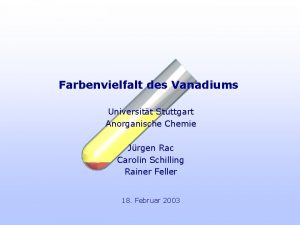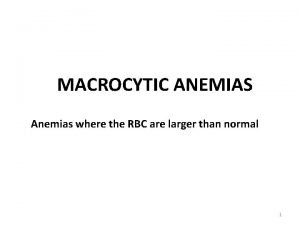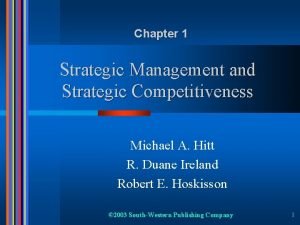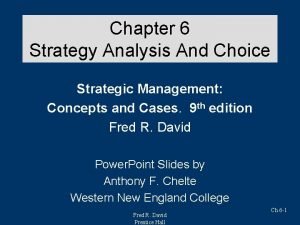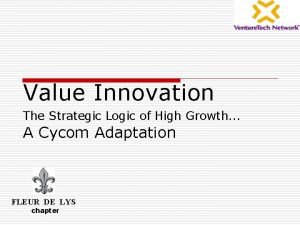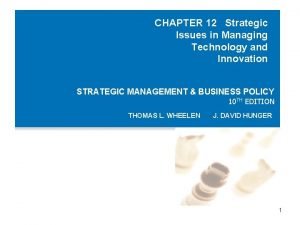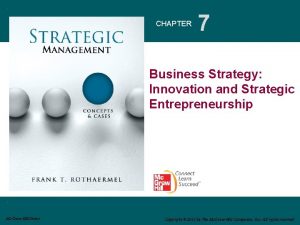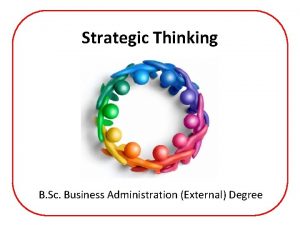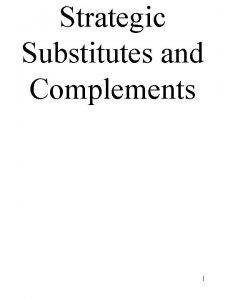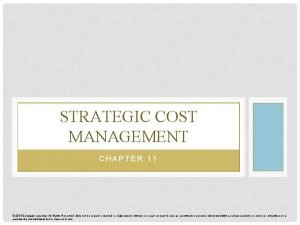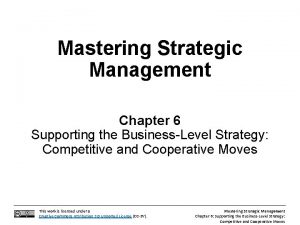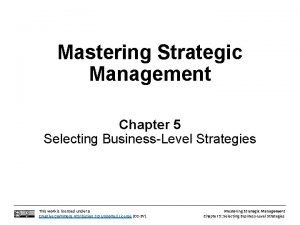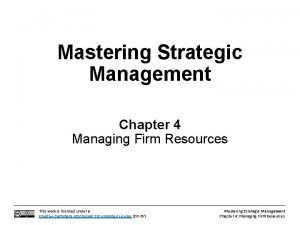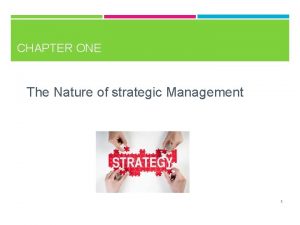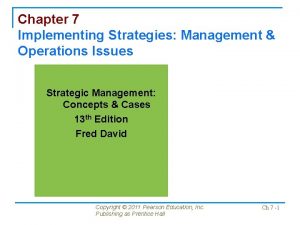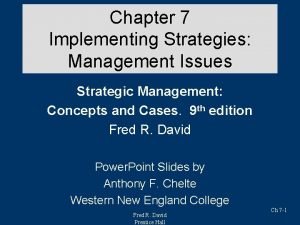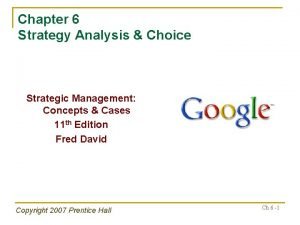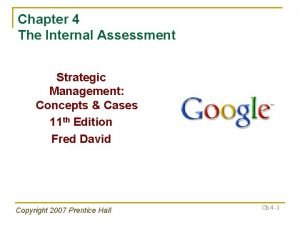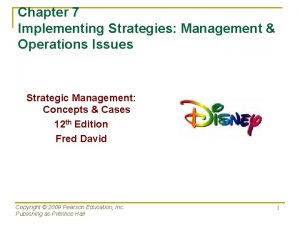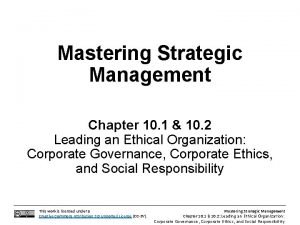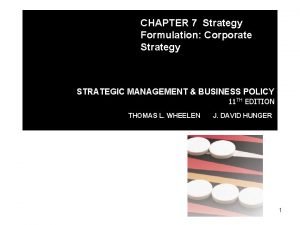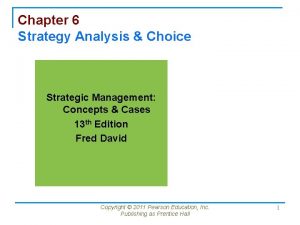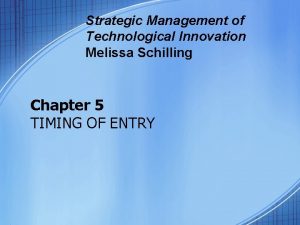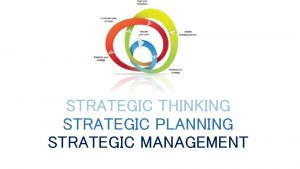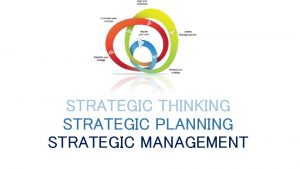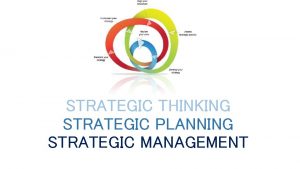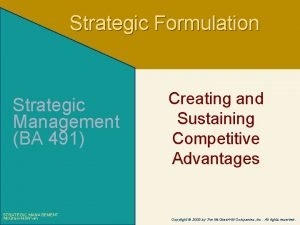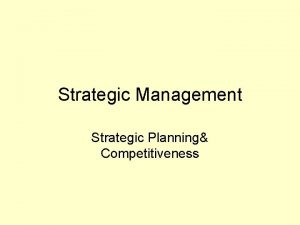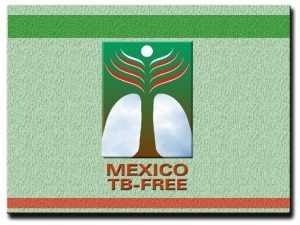Strategic Management of Technological Innovation Melissa Schilling Chapter


















































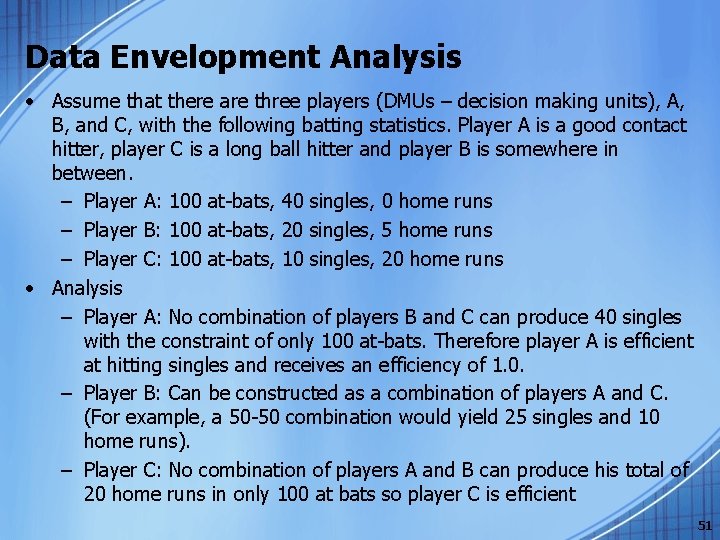
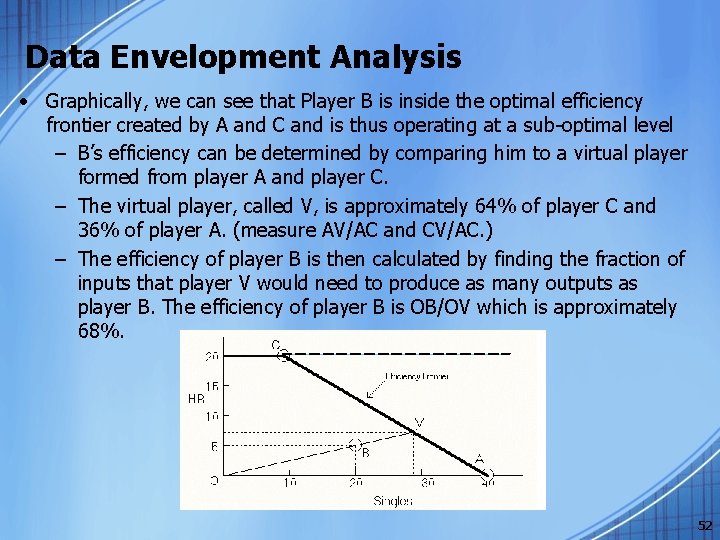
- Slides: 52

Strategic Management of Technological Innovation Melissa Schilling Chapter 7 CHOOSING INNOVATION PROJECTS

Boeing’s Sonic Cruiser • Boeing was developing a new midsized jet, the “Sonic Cruiser, ” which would travel 15 -20% faster than existing commercial jets. It was expected to cost $10 billion to develop. • However, in 2002 air ticket sales were down, several airlines faced bankruptcy, and aircraft were put into storage to reduce capacity. – Despite this, Boeing forecasted that the worldwide aircraft fleet would double by 2021. • Boeing also noted that the company needs to create a new aircraft every 12 to 15 years or else the people with the skills and experience will be either leave the company or retire and the next generation of employees will not have that knowledge passed on to them. 2

Boeing’s Sonic Cruiser • The Sonic Cruiser was scrapped but development of the 787 Dreamliner began and is scheduled to fly in 2009 – 50 percent of the primary structure, including the fuselage and wing, will be made of composite materials. This eliminates 1, 500 aluminum sheets and 40, 000 - 50, 000 fasteners. – health-monitoring systems will be incorporated that will allow the airplane to self-monitor and report maintenance requirements to ground-based computer systems. 3

The Development Budget • Most firms face serious constraints in capital and other resources they can invest in projects. • Firms thus often use capital rationing: they set a fixed R&D budget and rank order projects to support. – R&D budget is often a percentage of previous year’s sales. – Percentage is typically determined through industry benchmarking, or historical benchmarking of firm’s performance. 4

The Development Budget • R&D Intensity (R&D as a percent of sales) varies considerably across and within industries. Industry Software & Internet R&D as a Percent of Sales 12. 7% Health 11. 2 Computing & Electronics 7. 6 Technology 4. 3 Aerospace & Defense 4. 1 Automotive 4. 1 Industrials 2. 3 Consumer Products 2. 1 Telecom 1. 9 Chemicals & Energy 1. 5 5

The Development Budget • Top 20 Global R&D Spenders, 2004 – Microsoft’s 21% is higher than the 12. 7% of the Software 7 Internet industry – GM’s 3% is below the auto industry’s 4. 1% Company R&D Expenditures ($billions) R&D as percent of sales Microsoft $7. 8 21% Pfizer 7. 7 15% Ford 7. 4 Daimler. Chrysler Company R&D Expenditures ($billions) R&D as percent of sales Glaxo. Smith. Kline 5. 2 14% Intel 4. 8 14% 4% Volkswagen 4. 7 4% 7. 0 4% Sony 4. 7 7% Toyota 7. 0 4% Nokia 4. 6 13% General Motors 6. 5 3% Honda 4. 4 5% Siemens 6. 2 7% Samsung Electronics 4. 3 6% Matsushita Electric 5. 7 7% Novartis 4. 2 15% IBM 5. 7 6% Roche Holding 4. 1 17% Johnson & Johnson 5. 2 11% Merck 4. 0 18% 6

Theory In Action Financing New Technology Ventures – Large firms can fund innovation internally; new start-ups must often obtain external financing. – In first stages of start-up and growth, entrepreneurs may have to rely on family, friends, and credit cards. – Start-ups might be able to obtain some funding from government grants and loans (SBA, DOE, NASA, etc) – If idea and management are especially promising, entrepreneur may secure funds from “angel investors” (typically seed stage and <$1 million) or venture capitalists (multiple early stages, >$1 million). • In 2005, angel investors funded approximately 50, 000 ventures valued at $23. 1 billion 7

Venture vs Traditional Capital • Traditional – – – More fluid Bears lower return Invested based on immediate future Concerned with past performance Loaning bank is creditor and requires collateral • Venture capital – – – Less fluid Requires high return rate Invested based on longer-run future Concerned with product and market potential Venture capitalist and partner are co-owners • Venture capitalist brings credibility to the company and mentoring

Angel Funding • The angel investor market in the first half of 2007 has shown signs of a small retreat from the growth of the past several years, with total investments of $11. 9 billion, a decrease of 6% over the first half of 2006, (Center for Venture Research at the University of New Hampshire http: //wsbe. unh. edu/cvr) • A total of 24, 000 entrepreneurial ventures received angel funding in the first half of 2007, a 2% decline from the first half of 2006. • The number of active investors in the first half of 2007 was 140, 000 individuals (8% above Q 1 Q 2 2006) though the total dollar size of the market and the number of investments exhibited a slight decline from Q 1 Q 2 2006 • Reflecting this trend is the decrease in the average deal size by 4% over the first half of 2006 and an increase (10%) in the number of investors per deal.

Angel Funding Sector Analysis Q 1 Q 2 2007 • Healthcare services/medical devices/equipment and software remained the sectors of choice, with 22% and 14%, respectively, of total angel investments in the first half of 2007. • This was followed closely by biotech at 10%. • Electronics/computer hardware, IT services, retail and industrial/energy garnered close to 10% each. • The remaining investments were approximately equally weighted across high tech sectors, with each having 3 -5% of the total deals. Sector Health Software Biotech Electronics IT Services Retail Industrial/Energy Deals 22% 14% 10% 8% 7% 6% 6%

Angel Funding Analysis • Angels continue to be the largest source of seed and start-up capital in the United States, with 42% of the first half of 2007 angel investments in the seed and start-up stage. – This preference for seed and start-up investing is followed closely by post-seed/start-up investments of 48%. • While angels are not abandoning seed and start-up investing, it appears that market conditions, the preferences of large formal angel alliances, and a possible slight restructuring of the angel market are resulting in angels engaging in more later-stage investments. • This restructuring of the angel market has in turn resulted in fewer dollars available for seed investments, thus exacerbating the capital gap for seed and start-up capital in the US. • In the first half of 2007 angels exited their investments primarily through sale of the business (acquisitions by another firm), with 61% of the first half 2007 exits through trade sales. • Exits by initial public offerings represented 6% of exits and bankruptcy occurred in 33% of the exits. • For all these exits the average rate of return was 30 -40% and roughly half (52%) were at a profit.

Venture Capital Funding Analysis • Venture capitalists invested $29. 4 billion in 3, 813 deals in 2007 —marking the highest yearly investment total since 2001. – The total invested in 2007 represents a 10. 8 percent increase in dollars and a five percent increase in deal volume over 2006. – Much of the increase in investments over the prior year can be attributed to record investment levels in the Clean Technology and Life Sciences sectors as well as strong investment levels in Internet-specific companies. • Investments in the fourth quarter of 2007 totaled $7. 0 billion in 963 deals, marking the fourth straight quarter with investments totaling more than $7 billion—a phenomenon not seen since 2001. Source http: //www. nvca. org/pdf/07 Q 4 MTRel. Embargo. FINAL. pdf

VC Sector and Industry Analysis • The Life Sciences sector (Biotechnology and Medical Device industries together) set an all-time record for venture capital investing in 2007 with $9. 1 billion in 862 deals, compared to $7. 6 billion going into 786 deals in 2006. – The most significant growth was seen in the Medical Device industry, which rose 40% in 2007 to $3. 9 billion going into 385 deals. For the year, Life Sciences accounted for 31% of all venture capital invested, which also represents an all-time high. – Life Sciences also retained its position as the number one investment sector for 2007. • Software investing remained relatively flat in 2007, consistent with levels over the last five years with $5. 3 billion going into 905 deals, compared to $5. 1 billion going into 920 deals in 2006. – Despite the lack of growth, it still remained the largest single industry category for the year both in terms of deals and dollars, edging out Biotechnology for the top position. 13

VC Sector and Industry Analysis • The Clean Technology sector (alternative energy, pollution and recycling, power supplies and conservation) which represented two of the five biggest deals of the year, experienced significant growth in 2007 with $2. 2 billion invested in 201 deals. – This investment level represents a 46% growth in dollars and a 57% growth in deal volume over 2006 when $1. 5 billion was invested in 128 companies. • Internet-specific companies received $4. 6 billion in 748 deals in 2007, an increase of 12% and 8%, respectively, over 2006 when these companies received $4. 1 billion in 691 deals. – ‘Internet-specific’ refers to a company whose business model is fundamentally dependent on the Internet, regardless of the company’s primary industry category. These companies accounted for 16 percent of all venture capital dollars in 2007, approximately the 14 same percentage as in 2006.

VC Sector and Industry Analysis • The Media and Entertainment industry saw more venture capital dollars in 2007, with $1. 9 billion going into 340 deals compared to 2006 when $1. 7 billion went into 318 deals. • Other industries that saw increases in deals and dollars during the year include Business Products and Services, Financial Services, IT Services, and Retailing/Distribution. • Telecom companies saw a decrease in investment in 2007 with 290 deals receiving $2. 1 billion dollars, a drop from the $2. 6 billion in 301 deals they captured in 2006. • Other industries that experienced declines in deals and dollars in 2007 include Healthcare Services, Semiconductors, and Electronics/Instrumentation. 15

Total equity investments into venture-backed companies Q 1 2001—Q 4 2007 16

Most active venture investors 2007 • The most active venture firms in the US closed 20 or more deals each in 2007. • For the third year in a row, Draper Fisher Jurvetson topped the list of most active venture firms for the full-year, completing 100 deals in 2007, up from the 82 deals they participated in during 2006. • Like last year, New Enterprise Associates and Intel Capital rounded out the top three firms. • Making a big move up the list was Canaan Partners; whose 50 deals completed in 2007 was 28 percent higher than the 39 deals completed in 2006. For the year, the top 10 firms invested in eight percent of all the deals done in 2007. 17

Most active venture investors 2007 http: //www. pwcmoneytree. com/MTPublic/ns/moneytree/filesource/exhibits/National_Money. Tree_full_year_Q 4_2007_Final. pdf 18

Quantitative Methods for Choosing Projects • The difference between the present value of cash inflows and the present value of cash outflows. NPV is used in capital budgeting to analyze the profitability of an investment or project. • NPV compares the value of a dollar today to the value of that same dollar in the future, taking inflation and returns into account. If the NPV of a prospective project is positive, it should be accepted. However, if NPV is negative, the project should probably be rejected because cash flows will also be negative. • For example, if a retail clothing business wants to purchase an existing store, it would first estimate the future cash flows that store would generate, and then discount those cash flows into one lump-sum present value amount, say $565, 000. – If the owner of the store was willing to sell his business for less than $565, 000, the purchasing company would likely accept the offer as it presents a positive NPV investment. – Conversely, if the owner would not sell for less than $565, 000, the purchaser would not buy the store, as the investment would present a negative NPV at that time and would, therefore, reduce the overall value of the clothing company. 19

Quantitative Methods for Choosing Projects • NPV = Net Present value = Present value of net cash flows – Each cash inflow/outflow is discounted back to its PV and then they are summed. or shortened t - the time of the cash flow N - the total time of the project r - the discount rate (the rate of return that could be earned on an investment in the financial markets with similar risk. ) Ct - the net cash flow (the amount of cash) at time t (for educational purposes, C 0 is commonly placed to the left of the sum to emphasize its role as the initial investment. ). 20

Quantitative Methods for Choosing Projects • Commonly used quantitative methods include discounted cash flow methods and real options. – Discounted Cash Flow (DCF) • Net Present Value (NPV): Expected cash inflows are discounted and compared to outlays. • In Excel use the formula NPV(interest rate, cell range of cashflows) $943. 39 21

Quantitative Methods for Choosing Projects • Internal Rate of Return (IRR): The discount rate that makes the net present value of investment zero. – It is an indicator of the efficiency of an investment, as opposed to NPV, which indicates value or magnitude. – The IRR is the annualized effective compounded return rate which can be earned on the invested capital, i. e. , the yield on the investment. – A project is a good investment proposition if its IRR is greater than the rate of return that could be earned by alternate investments (investing in other projects, buying bonds, even putting the money in a bank account). • Thus, the IRR should be compared to any alternate costs of capital including an appropriate risk premium. 22

Quantitative Methods for Choosing Projects – Mathematically the IRR is defined as any discount rate that results in an NPV of zero of a series of cash flows. – In general, if the IRR is greater than the project's cost of capital, or hurdle rate (minimum rate of return that must be met for a company to undertake a particular project) , the project will add value for the company. 23

Quantitative Methods for Choosing Projects 24

Quantitative Methods for Choosing Projects • Strengths and Weaknesses of DCF Methods: – Strengths • Provide concrete financial estimates • Explicitly consider timing of investment and time value of money – Weaknesses • May be deceptive; only as accurate as original estimates of cash flows. • May fail to capture strategic importance of project – Technology development plays a crucial role in building and leveraging firm capabilities and creating options for the future • Intel’s investment in DRAM technology must have been considered a total loss by NPV methods, however it laid the foundation for Intel’s ability to develop microprocessors which proved enormously profitable • Thus, some managers and scholars have promoted the idea of treating new product development decisions as real options 25

Quantitative Methods for Choosing Projects • Real Options: Applies stock option model to nonfinancial resource investments. e. g. , with respect to R&D: – The cost of the R&D program can be considered the price of a call option. – The cost of future investment required to capitalize on the R&D program (such as the cost of commercializing a new technology that is developed) can be considered the exercise price. – The returns to the R&D investment are analogous to the value of a stock purchased with a call option. 26

Quantitative Methods for Choosing Projects • Real options are based on stock options – A call option on a stock enables an investor to purchase the stock at a specified price (the exercise price) in the future • If, in the future, the stock is worth more than the exercise price, the holder of the option will typically exercise the option by buying the stock – If the stock is worth more than the exercise price plus the price paid for the original option, the option holder makes a profit – If it is worth less, the option holder will typically choose not to exercise the option, allowing it to expire. The amount paid for the initial option is a loss. • If the stock is worth more than the exercise price but not more than the exercise price plus the amount paid for the original option, the stockholder will typically exercise the option. The amount lost is less than if the option were to expire. 27

Quantitative Methods for Choosing Projects – Examples of real call options 28

Value of a call option at expiration • The value of a call option is zero as long as the price of the stock remains less than the exercise price • If the value of the stock rises above the exercise price, the value of the call rises with the value of the stock, dollar for dollar (thus the 45 -degree angle) 29

Quantitative Methods for Choosing Projects • Options are valuable when there is uncertainty (as in innovation) – Some research shows that an option approach results in better technology investment decisions than a cash flow analysis approach • However, real options models have some limitations: – Many innovation projects do not conform to the same capital market assumptions underlying option models. • May not be able to acquire option at small price: may require full investment before its known whether technology will be successful. • Value of stock option is independent of call holder’s behavior, but the future returns of the of R&D investment can be significantly influenced by the firm’s capabilities, complementary assets, and strategies. – Rather than being an observer (as in the option scenario), the investor can be an active driver of the value of the investment 30

Qualitative Methods of Choosing Projects • Many factors in the choice of development projects are extremely difficult (or misleading) to quantify. • Almost all firms thus use some qualitative methods. – Screening Questions may be used to assess different dimensions of the project decision including: • Role of customer (market, use, compatibility and ease of use, distribution and pricing) • Role of capabilities (existing capabilities, competitors’ capabilities, future capabilities) • Project timing and cost (time to complete, first to market, readiness of market, project cost, other costs) – Can create a scoring mechanism that can weight the questions according to importance – Even if Boeing’s Sonic Cruiser project would not be profitable based on quantitative analysis, it may be necessary just to pass on the skills and experience of building an airplane to the next generation of employees. That value is difficult to asses quantitatively but is revealed by qualitative analysis 31

Qualitative Methods of Choosing Projects – The Aggregate Project Planning Framework • Managers map their R&D projects according to levels of risk, resource commitment and timing of cash flows 32

Qualitative Methods of Choosing Projects • Advanced R&D Projects: develop cutting-edge technologies; often no immediate commercial application. • Breakthrough Projects: incorporate revolutionary new technologies into a commercial application. • Platform Projects: not revolutionary, but offer fundamental improvements in cost, quality and performance of a technology over preceding generations of products. • Derivative Projects: incremental improvements in products and/or processes to provide a variety in design features. – Toyota’s Camry platform offers LE, SE and XLE models to appeal to different market segments • Derivative projects pay off the quickest, and help service the firm’s short -term cash flow needs. Advanced R&D projects take a long time to pay off (or may not pay off at all), but can position the firm to be a technological leader. 33

Qualitative Methods of Choosing Projects – Managers then compare actual balance of projects with desired balance of projects. • A typical firm experiencing moderate growth might allocate 10% of it’s R&D budget to breakthrough innovation, 30% to platform projects and 60% to derivative projects • A firm pursuing a more significant growth might allocate higher percentages to breakthrough and platform projects • A firm that needs to generate more short-term profit might allocate a higher percentage to derivative projects 34

Qualitative Methods of Choosing Projects – Mapping the company’s R&D portfolio encourages the firm to consider both short-term cash flow needs and long-term strategic momentum in its budgeting and planning • A firm that invests heavily in in derivative products that may be immediately commercialized with little risk may appear to have good returns on its R&D investment in the short run, but then be unable to compete when the market shifts to newer technology • A firm that invests heavily in advanced R&D or breakthrough projects may be on the leading edge of technology but run into cash flow problems from a lack of revenues generated from recently commercialized platform or derivative projects • Jack Welch, former CEO of GE – “You can’t grow long term if you can’t eat short term. Anyone can manage short. Anyone can manage long. Balancing those two things is what management is” – Because the development of a new drug takes 10 -15 years at a cost of $800 million and drug companies have become reliant on a few blockbuster drugs for a significant share of their revenues, drugs firms could experience extreme volatility in their sales revenue 35

Drug Firms’ Reliance on a Few Blockbuster Products, 2000 36

Qualitative Methods of Choosing Projects – Q-Sort is a simple method for ranking ideas on different dimensions. • Used for many diverse purposes – from identifying personality disorders to establishing scales of customer preferences • Individuals in a group are each given a stack of cards with an object or idea on each card (e. g. , a potential project). • A series of project selection criteria are presented (technical feasibility, market impact, fit with strategic intent) and, for each criterion, the individuals sort their cards in rank order (e. g. , best fit with strategic intent) or in categories (technically feasible vs infeasible) according to that criterion • Individuals compare their ran ordering and use these comparions to structure a debate about the projects • After several rounds of sorting and debating, the group is expected to arrive at a consensus about the best projects. 37

Combining Quantitative and Qualitative Information • Managers may use multiple methods in combination. – Use quantitative methods to estimate the cash flows anticipated from a project when balancing their R&D portfolio on a project map • May also use methods that convert qualitative information into quantitative form (though this has similar risks as discussed with quantitative methods) – Conjoint Analysis estimates the relative value individuals place on attributes of a choice which can then be used in development and pricing decisions. • Individuals given a card with products (or projects) with different features and prices. • Individuals rate each in terms of desirability or rank them. • Multiple regression then used to assess the degree to which an attribute influences rating. These weights quantify the trade-offs involved in providing different features. 38

Conjoint Analysis • Conjoint analysis is a popular marketing research technique that marketers use to determine what features a new product should have and how it should be priced. • Conjoint analysis became popular because it was a far less expensive and more flexible way to address these issues than concept (market) testing. • Suppose we want to market a new golf ball. We know from experience and from talking with • golfers that there are three important product features: – Average Driving Distance – Average Ball Life – Price • There is actually a range of feasible alternatives for each of these features: Average Driving Distance Average Ball Life Price 275 yards 54 holes $1. 25 250 yards 36 holes $1. 50 225 yards 18 holes $1. 75 39

Conjoint Analysis • Obviously, the market’s “ideal” ball would be: Average Driving Distance Average Ball Life Price 275 yards 54 holes $1. 25 • and the “ideal” ball from a cost of manufacturing perspective would be: Average Driving Distance Average Ball Life Price 225 yards 18 holes $1. 75 – assuming that it costs less to produce a ball that travels a shorter distance and has a shorter life. • The basic marketing issue: We’d lose our shirts selling the first ball and the market wouldn’t buy the second. The most viable product is somewhere in between, but where? Conjoint analysis lets us find out where. 40

Conjoint Analysis • A traditional research project might start by considering the rankings for distance and ball life as follows: Rank Avg Driving Distance Rank Avg Ball Life 1 275 yards 1 54 holes 2 250 yards 2 36 holes 3 225 yards 3 18 holes • This type of information doesn’t tell us anything that we didn’t already know about which ball to produce. 41

Conjoint Analysis • Now consider the same two features taken conjointly. • The next two figures show the rankings of the 9 possible products for two buyers assuming price is the same for all combinations. 42

Conjoint Analysis • Both buyers agree on the most and least preferred ball. But as we can see from their other choices, Buyer 1 tends to trade-off ball life for distance, whereas Buyer 2 makes the opposite trade-off. • The knowledge we gain in this analysis is the essence of conjoint analysis. 43

Conjoint Analysis • Next, let’s figure out a set of values for driving distance and a second set for ball life for Buyer 1 so that when we add these values together for each ball they reproduce Buyer 1's rank orders. • Here’s one possible scheme. – Note that we could have picked many other sets of numbers that would have worked, so there is some arbitrariness in the magnitudes of these numbers even though their relationships to each other are fixed. 44

Conjoint Analysis • Next suppose that the table below represents the trade-offs Buyer 1 is willing to make between ball life and price. • Starting with the values we just derived for ball life, the next table shows a set of values for price that when added to those of ball life reproduce the rankings for Buyer 1 in the table above. 45

Conjoint Analysis • We now have in the table below a complete set of values (referred to as “utilities” or “part-worths”) that capture Buyer 1's trade-offs. • We can now use this information to determine which ball to produce. 46

Conjoint Analysis • Suppose we were considering one of two golf balls shown in the table below • The values for Buyer 1, when added together, give us an estimate of his preferences. • Applying these to the two golf balls we’re considering, we get these results • We’d expect buyer 1 to prefer the long-life ball over the distance ball since it has the larger total value 47

Theory In Action: Courtyard by Marriot • Marriot used conjoint analysis to help it develop a midprice hotel line. • First used focus groups to identify customer segments and attributes they cared about in a hotel. These included: – external surroundings, room, food, lounge, services, leisure activities and security • Then created potential hotel profiles that varied on these features and asked participants to rate the profiles. – For example, under the services factor was reservations • Two levels were devised- Call the hotel directly or call an 800 reservation number – A sample of hotel customers were given 7 cards, each containing one of the factors above with a dollar value assigned to each level of service within a factor. A maximum of $35 could be budgeted to creating a profile of features • If the budget was exceeded, features had to be eliminated or a less expensive level of services had to be chosen • The participants set their own priorities and made their own trade-offs. This help management understand what was important to different customer segments 48

Theory In Action: Courtyard by Marriot • Participants werethen asked to rate each of the profiles created • Regression was then used to assess how different levels of service within a specific attribute influenced customer ratings of the hotel overall • Based on the results, Marriott developed Courtyard concept: relatively small hotels with limited amenities, small restaurants and meeting rooms, courtyards, high security, and rates of $40 -$60 a night. • By the end of 2002, there were 553 Courtyard hotels and their average occupancy rate of 72% was well above the industry average 49

Combining Quantitative and Qualitative Information • Data Envelopment Analysis (DEA) uses linear programming to combine measures of projects based on different units (e. g. , rank vs. dollars) into an efficiency frontier. – Projects can be ranked by assessing their distance from efficiency frontier. – As with other quantitative methods, DEA results only as good as the data utilized; managers must be careful in their choice of measures and their accuracy. – DEA has been applied in many situations such as: • • health care (hospitals, doctors), education (schools, universities) banks, manufacturing benchmarking, management evaluation fast food restaurants, retail stores 50

Data Envelopment Analysis • Assume that there are three players (DMUs – decision making units), A, B, and C, with the following batting statistics. Player A is a good contact hitter, player C is a long ball hitter and player B is somewhere in between. – Player A: 100 at-bats, 40 singles, 0 home runs – Player B: 100 at-bats, 20 singles, 5 home runs – Player C: 100 at-bats, 10 singles, 20 home runs • Analysis – Player A: No combination of players B and C can produce 40 singles with the constraint of only 100 at-bats. Therefore player A is efficient at hitting singles and receives an efficiency of 1. 0. – Player B: Can be constructed as a combination of players A and C. (For example, a 50 -50 combination would yield 25 singles and 10 home runs). – Player C: No combination of players A and B can produce his total of 20 home runs in only 100 at bats so player C is efficient 51

Data Envelopment Analysis • Graphically, we can see that Player B is inside the optimal efficiency frontier created by A and C and is thus operating at a sub-optimal level – B’s efficiency can be determined by comparing him to a virtual player formed from player A and player C. – The virtual player, called V, is approximately 64% of player C and 36% of player A. (measure AV/AC and CV/AC. ) – The efficiency of player B is then calculated by finding the fraction of inputs that player V would need to produce as many outputs as player B. The efficiency of player B is OB/OV which is approximately 68%. 52
 The importance of technology
The importance of technology Mysite socccd
Mysite socccd Disruptive and radical innovation
Disruptive and radical innovation Perhitungan leukosit dengan kamar hitung
Perhitungan leukosit dengan kamar hitung Schilling chemie
Schilling chemie Mitral facies
Mitral facies Megaloblastic anemia mcv
Megaloblastic anemia mcv Norbert schilling
Norbert schilling Schilling test
Schilling test Alexandra schwarz schilling
Alexandra schwarz schilling Role of folate in the body
Role of folate in the body Dr kate schilling
Dr kate schilling Schilling test
Schilling test Escala khorana
Escala khorana Strategic competitiveness
Strategic competitiveness Strategy analysis and choice largely involves making
Strategy analysis and choice largely involves making Value innovation the strategic logic of high growth
Value innovation the strategic logic of high growth Strategic issues in managing technology and innovation
Strategic issues in managing technology and innovation Business strategy innovation and strategic entrepreneurship
Business strategy innovation and strategic entrepreneurship Strategic fit vs strategic intent
Strategic fit vs strategic intent Strategic substitutes example
Strategic substitutes example Process of strategic cost management
Process of strategic cost management Mastering strategic management
Mastering strategic management Strategic management chapter 5
Strategic management chapter 5 Strategic management chapter 4
Strategic management chapter 4 Strategic management nature
Strategic management nature Chapter 9 strategic management
Chapter 9 strategic management Chapter 7 strategic management
Chapter 7 strategic management Chapter 7 strategic management
Chapter 7 strategic management Chapter 7 strategic management
Chapter 7 strategic management Chapter 6 strategy analysis and choice
Chapter 6 strategy analysis and choice Internal assessment strategic management
Internal assessment strategic management Organization and management chapter 3 planning
Organization and management chapter 3 planning Strategic management chapter 7
Strategic management chapter 7 Mis issues in strategy implementation
Mis issues in strategy implementation Chapter 3 the external assessment
Chapter 3 the external assessment Strategic management chapter 10
Strategic management chapter 10 Strategic cost management chapter 1
Strategic cost management chapter 1 Establish accurate controls
Establish accurate controls Chapter 2 strategic management
Chapter 2 strategic management Corporate strategy growth stability retrenchment
Corporate strategy growth stability retrenchment Strategy analysis and choice
Strategy analysis and choice Chapter 5 strategic management
Chapter 5 strategic management Visvesvaraya technological university nagpur
Visvesvaraya technological university nagpur Technological discontinuity definition
Technological discontinuity definition Technology risk definition
Technology risk definition What is technological modelling
What is technological modelling Technological leader
Technological leader Technological gap and product cycle model
Technological gap and product cycle model Technological design process definition
Technological design process definition Pest political economic social technological
Pest political economic social technological Institute for prospective technological studies
Institute for prospective technological studies Example of technological convergence
Example of technological convergence




